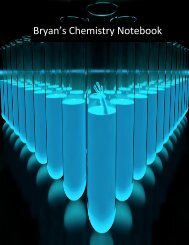You also want an ePaper? Increase the reach of your titles
YUMPU automatically turns print PDFs into web optimized ePapers that Google loves.
The Learning Goal for this section is:<br />
The student will learn how the rate of a chemical reaction can be controlled, what the role of energy is<br />
and why some reactions occur naturally and others do not.<br />
You are going to answer these 15 questions first in the order they are given to you. This will be a<br />
quiz grade. You are then going to explain the chemical concepts that are used in each question. You<br />
can do this in the order given or group them by concepts. You can use your book or information<br />
found on the internet but all information must be written in your own word. The font needs to be Arial<br />
12. This is due on Monday April 24 by midnight in the drop box. This document should be a 6-<br />
page pdf.<br />
1.B 6.B 11.A<br />
2.C 7.B 12.D<br />
3.C 8.D 13.C<br />
4.D 9.A 14.D<br />
5.A 10.B 15.D<br />
1 This graph represents the change in energy for two laboratory trials of the same reaction.<br />
Which factor could explain the energy difference between the trials?<br />
A Heat was added to trial #2.<br />
B A catalyst was added to trial #2.<br />
C Trial #1 was stirred.<br />
D Trial #1 was cooled.<br />
Explanation: IN the first trial, the amount of energy required for the reaction to take place is more than<br />
the amount in the second trial. A catalyst reduces the activation energy for the reaction to take place.<br />
Collisions only result in a reaction if the particles collide with a certain minimum energy called the<br />
activation energy for the reaction. To increase the rate of a reaction you need to increase the number<br />
of successful collisions. One possible way of doing this is to provide an alternative way for the<br />
reaction to happen which has a lower activation energy.<br />
2 Consider this balanced chemical equation:<br />
Which will increase the rate of the reaction?<br />
A increasing pressure on the reaction<br />
B decreasing concentration of the reactants<br />
C adding a catalyst to the reaction<br />
D decreasing the temperature of the reaction<br />
142<br />
2H2O2 (aq) → 2H2O(l) + O2 (g)




